Panasonic Lumix. The Stasha, the world’s lightest nesting dinghy. Weighs as much as a baby bird (wandering albatross chick)
There’s a saying that I like. ‘If you get in a car and don’t know where you’re going, you’ll never get there’. Designing a boat is a bit like this as you need to know a few things before you can begin. Knowing where to start is easier said than done. So many things can influence the design. I have found that a good place to start is to first think about what you don’t want. For example, I didn’t want a heavy dinghy. Nothing spoils the dinghy experience more than a weighty tender that is hard to move about and stow. This was my starting point. No matter what shape or size of dinghy I came up with it wouldn’t be a heavy one!
For years, I’d been intrigued by boats I’d seen in America that were made using materials from light aircraft. Constructed from a framework of wood and covered in cloth, they looked fragile but were obviously quite tough and since I was determined to keep the weight down I would also have to employ a similar system. So deciding what I didn’t want from my dinghy led me to the construction technique I was going to use.
However, there’s no point having a light dinghy if you have no where to put it. My yacht is just 24 feet long and the only place I could think of to stow a dinghy where it wouldn’t be in the way, look ugly or be unseaworthy was on the tiny foredeck. I got my tape measure out and discovered that it was about 4 feet wide at the aft end where the cabin begins and was a bit more than 4 feet from there to the bows. So it would have to be a nesting dinghy. In theory it could be about 7 feet long when assembled and that was a good size for a small yacht. And so was born the idea of making a super lightweight nesting dinghy.
Leica M9, 21mm f2.8 Asph. Stasha dinghy, nested and stowed on the deck of a Pacific Seacraft Dana 24.
There’s not much point worrying about aesthetics when you are designing a dinghy, the most important thing in my opinion is stability. There is nothing worse than a tippy dinghy, except perhaps a heavy tippy dinghy. Light boats are less stable than heavy boats so I would be relying mainly on the shape of the boat to provide stability. This meant that it had to be as square as possible. I now had enough information to design the boat’s shape.
The rest of it would be guesswork based on experience. What would happen if I cut a boat in half to make it nest? Would it be strong enough? What kind of forces would the join be under? How would the stringers attach to the end panels? These and many more questions filled my brain. As far as I could tell, no one had ever built a dinghy like this and I wondered why. Have people tried it but drowned during testing or has no one ever tried? Maybe it was a stupid idea that would never work but one of the great beauties of a lightweight boat is that they are cheap to build. Less materials means less cost. I could afford to simply make a boat and see if it worked.
Normally nesting dinghies are made so that the front section comes off and fits inside the rear section but this does not seem logical to me for many reasons. The shape of the front section always needs to be quite pointed but this reduces stability too much. It also means that the interior volume of the dinghy is much reduced so you might have an eight foot nesting dinghy but it will feel much smaller. Then there’s the rowing position. It’s perfectly logical to put a thwart on or above the join but it leads to a bows down attitude when rowing which makes the dinghy hard to row and just looks wrong. Rowing is easier when the bows are slightly up.
The whole concept seemed flawed to me so I tried a bit of lateral thinking and did some sketches with the rear section fitting into the front section and suddenly everything started to make more sense. The most obvious problem with doing it this way around was that the rear section would be slightly narrower than the front which would mean a step where they join. In fact this is not a problem as the bottom of the dinghy remains flush, it’s just the sides that have a small step. I doubted if it would make an appreciable difference to the finished boat’s performance.
Leica M9, 21mm f2.8 Asph. Sunlight glows through the translucent skin of the Stasha. Note the small step at the join.
This one compromise seemed a small price to pay for the host of advantages that it brought the design. I could have a fairly fine bow, a good interior volume, great stability and a perfect rowing position. Another bonus with this set up is that the rowing position doesn’t have to change when you take a passenger. Not only this but if the passenger sits in the front section back to back with the rower, the combined weight is centred in the boat increasing stability still further and each occupant has a clear, unobstructed view of their surroundings. This is much more pleasant for everyone. Yet another advantage was the fact that the pintles for the rudder are stowed inside the nested boat so ropes can’t get caught on them.
To simplify the building process, I decided to do away with any hint of sheer and make the top of the boat completely straight. Simplifying the wood requirements would also make the boat easier and cheaper to build. Now I had all the information I needed to start to design the boat. I made a few sketches just to see how it would look. Although it was boxy it still had a nice boat like shape which was pleasing.
Next I made a 1 -10 scale cardboard model 220mm long. I wanted a near flat bottom for maximum stability and ease of build but I suspected that the fine framework allied with the pressure of the water on the hull would flex inwards so I incorporated a slight V into the bottom. This would also add more strength to the structure. The sides are almost upright, with only a slight angle outwards. Again, this increases interior volume and stability.
The simplest way to build a boat like this is to make a jig. Panels are cut out and screwed to the jig and then the stringers and ribs are attached to it to create the framework. Happy with my cardboard model I divided it up into 5 sections and used these measurements to make the stations that would dictate it’s shape. I scaled up the measurements by simply adding a zero. Then these measurements were converted into instructions using the simple ‘join the dots’ principal that all Woodenwidget dinghies are built with.
Leica M9, 21m f2.8 Asph. This photo shows the jig for the front section with all panels, stringers and ribs in place.
Deciding how many stringers and ribs to use was decided by guesswork based on experience and finally what ‘looks right’ while trying to minimise weight and keep the build simple. Obviously the more ribs you have the more work there is to make and fit them. Since lack of weight was everything I did err on the light side.
The end panels on the jig stay as part of the boat while the inner stations are only temporary. The end panels have slots cut in them to accommodate the stringers which are then glued in with epoxy resin. The stringers are held in place on the inner stations with cable ties. The following day the ribs are made and glued in place. The ribs are glued everywhere they touch a stringer. This gives over 60 glue joins which makes for a surprisingly strong structure.
The making of the ribs caused me some concern. On the one hand I wanted the dinghy to be easy to build but it had to be light too. I considered a system that had no bent ribs but it meant making nearly 40 mortices which would take a long time and require a certain skill. It would also add weight and complication. So I decided to take a fresh look at bending ribs with heat.
At some point most boat builders will have a go at steaming wood. It’s a lot of fun and it’s amazing what you can put a piece of wood through before it breaks. If you want to really understand wood this is a great way to do it. You will walk away with a new respect for it as a material.
Some woods bend easier than others so I chose ash because it is strong and light as well as easy to bend. The straightness and orientation of the grain plays a big part in how far you can bend wood as does the amount of moisture content. Thin wood bends easier than thick wood but in any case you’ll need heat. Most boat builders will construct a steam box to do this but since there are only 9 ribs to be bent in the Stasha I needed to find a simpler way.
Pre soaking the wood for a couple of days is essential. Once the wood is completely saturated, they are fitted to the jig. The centre is clamped to the keel and each side of the rib is pushed down while applying heat from a hot air gun. The ribs are pushed down in gradual stages until they touch at all the stringers. This is a little time consuming and it helps to have patience but still easier than any other system I could devise. It’s also the lightest way and gives the dinghy a nice rounded boat shape. This also makes it easier to fit the cloth later.
Leica M9, 21mm f2.8 Asph. This shot shows one of the ribs being gradually persuaded into place with heat from a hot air gun.
The ribs are then glued where they touch at all the stringers. A day later the structure can be removed from the jig. It’s still quite floppy but gets much stronger at every stage. (To save wood, the stations are cut down to make the jig for the rear section of the dinghy). Inner gunwales and reinforcing knees are added for strength and that’s basically all there is to the wooden structure. Not one screw in it. It’s thanks to the amazing bonding strength of epoxy that a construction so light is even possible.
Leica M9, 21mm f2.8 Asph. Here’s the framework for the front section complete, just awaiting the kevlar twine and the cloth.
Now all the hard and messy work is done. All that remains is to cover the framework with a special heat shrink Dacron cloth. It’s attached with a product called Heat’n’Bond which is glue on a roll. It is melted with a humble domestic iron. This is cheap, light and very easy to use. It also sticks very well to the cloth and has excellent sheer force qualities. This Heat’n’Bond tape is applied to the keel, gunwales and end panels.
Now Kevlar twine is laid diagonally across the boat and glued to the gunwales. This helps to reduce twist in the structure and also to give more for the cloth to lay against than just the stringers. The cloth is laid on the structure and glued to the gunwales and end panels, then the iron is run over the cloth and all the wrinkles and baggy bits simply disappear leaving a drum tight smooth finish. This is very satisfying to do. The edges of the cloth are protected by small battens of wood and finally coated with a water based varnish but this is just one way to waterproof the fabric.
Leica M9, 21mm f2.8 Asph. Here the Dacron cloth has been glued in place. The remaining creases magically disappear when the iron is run over it.
Having made the two halves it was time to work out a way to join them. There’s no point having a nesting dinghy if it can’t be easily assembled either on land or on the water. Initially I thought about a very minimal bulkhead for the join along with some kind of waterproofing but that hardly seemed easy. Far better to sacrifice a little weight and have fuller, higher bulkheads. This means that each section is a boat in it’s own right so there is no need to waterproof the join at all. Two simple keyhole slots are all that is needed at the bottom of the join and two bolts at the top. Assembly takes less than a minute.
Leica M9, 21mm f2.8 Asph. Here the keyhole slot for joining the two sections can be seen.
What we have here is a basic 7 foot nesting rowing boat which is probably fine for most people especially as it rows so well but I also wanted it to sail. Because the rear section nests in the front section, centreboards and the like are out of the question and in any case fitting something like that would add weight and the potential for leaks. It would also be demanding to do and this doesn’t fit in with the easy build ethos.
The keel is bolted to the side of the boat and can swing up if you run aground. Here the slab sides are a bonus as it gives somewhere to attach the keel lower down. The mast support is made from two thwarts, the upper one bolts to the top of the gunwales and the lower one rests between the ribs below it. Diagonals of string must be added to help spread the load from the mast. Simple, effective and light. The mast and rudder from an Optimist is used with a slightly cut down sail.
If you want an outboard then you’ll have to reinforce and thicken the transom. This adds about half a kilo to the weight of the boat. This option has also been designed to be retro fitted at any time.
I am delighted with how well the boat has turned out. It is pretty, very light, easy to assemble, stows beautifully and fairly unobtrusively on the foredeck. The rowing position is excellent and very comfy. It goes fine with up to a 3.3hp outboard and sails surprisingly well with it’s modified Optimist rig.
Panasonic Lumix. The Stasha under sail using it’s cut down Optimist rig.
To be honest, I have been surprised at how well this boat works. I had no idea if it could take the stresses from a mast and keel or an engine but it has passed all these tests with flying colours and I’m still here to talk about it. Someone said it seems to ‘Dance on the water’ and it really does. It also slips along and carries it’s way amazingly well for such a light dinghy. Any doubts I might have had about the step in the hull are long forgotten, it seems to make no difference whatsoever. This can be confirmed by watching the water through the translucent hull as it passes the step. The boat hardly leaves a mark of it’s passing as it cuts through the water.
So this proves that if you follow sound basic small boat principals and keep faith with your original wants and don’t wants, you end up with a splendid little boat that is easy and fun to build in the smallest of places. It’s cheap to make and surprisingly tough. It stows away in a minute almost anywhere, including the back of an estate car. It rows well, sails well, takes an engine, two people with shopping and it does all this while weighing the same as a Wandering Albatross chick! (about 10 kilos! Very heavy for a baby bird perhaps but extremely light for a 7 foot dinghy)
Panasonic Lumix. The Stasha nested. It can be stowed upright if needed. Note the kevlar twine reinforcements.
To learn more and see some videos of the Stasha in action, please visit Woodenwidget.com
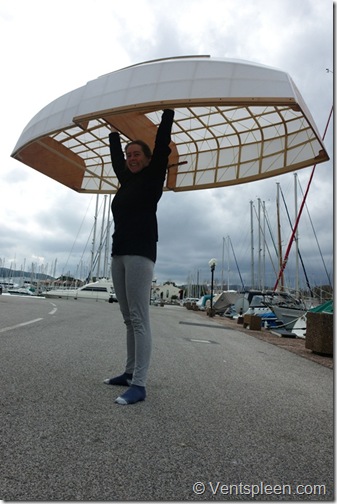
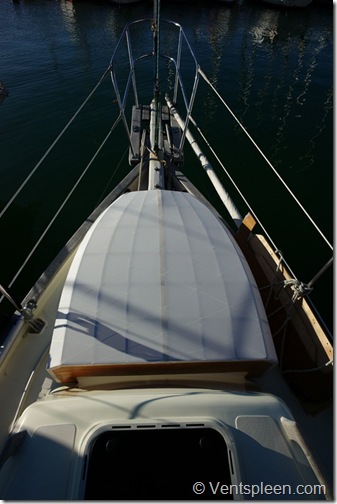
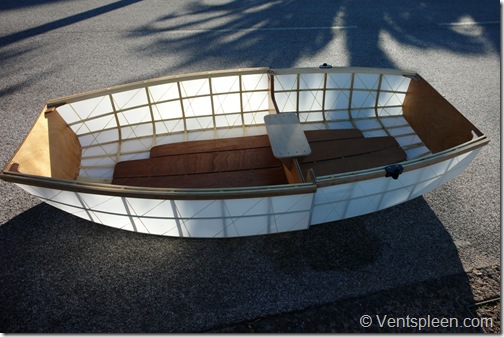
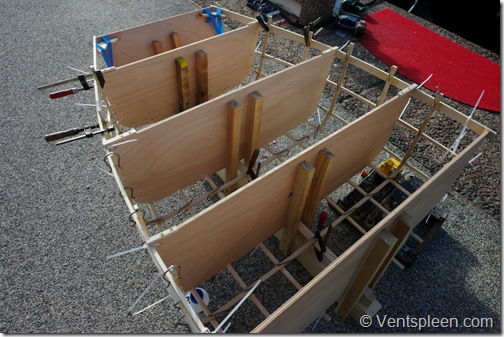
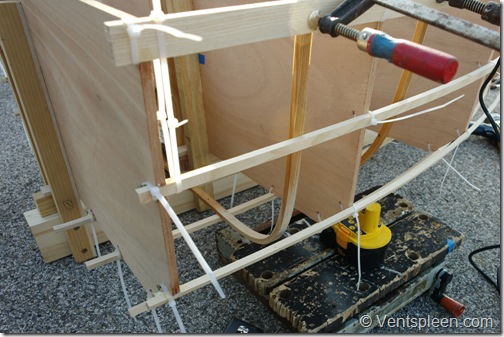
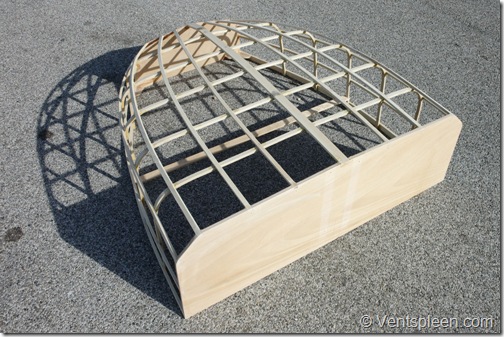
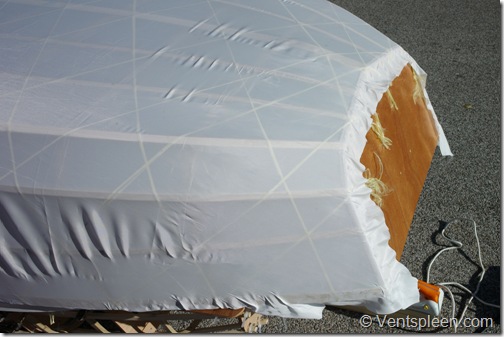
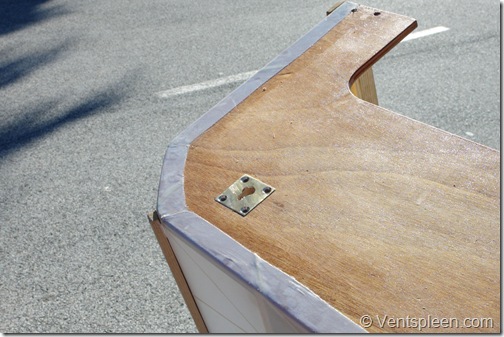
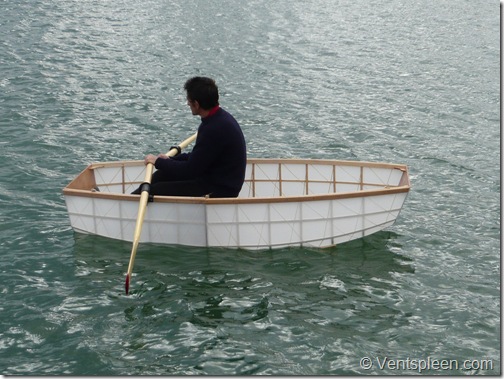
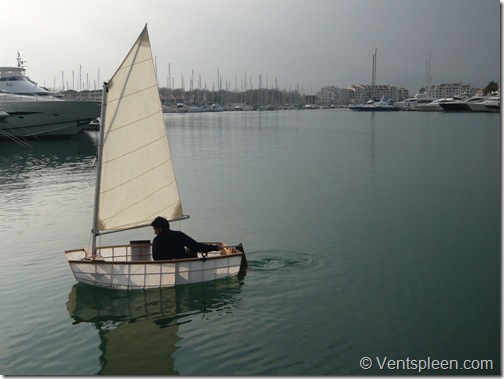
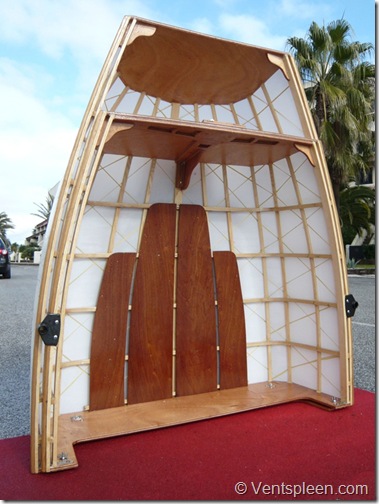
[…] Vu ce matin sur le quai avant le départ des bateaux pour la première régate : Le Stasha nesting dinghy. Avec ses 10 kg, c’est le dinghy le plus léger du monde. http://www.woodenwidget.com http://www.ventspleen.com/?p=209 […]
Congratulations!
As another owner of a small (26 foot) sailing boat with a small foredeck, and a certain disdain for lifting things, I must congratulate you on building what seems to be the perfect dinghy for this application. And the end result is quite beautiful as well.
Thanks for posting the details.
regards
Christian Nally
Galiano Island, B.C.
wyprawy…
Designing the lightest nesting dinghy in the world…
Could it be that two fitted blocks of foam, one on the bow and one on the stern, could make this craft unsinkable?